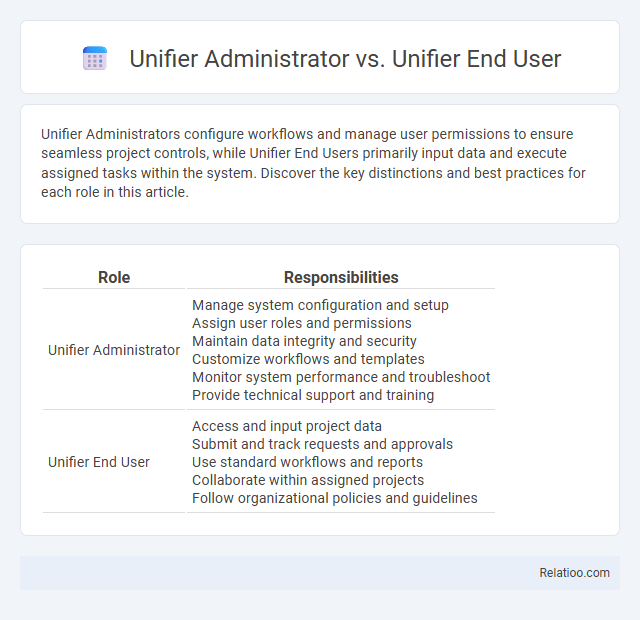Unifier Administrators configure workflows and manage user permissions to ensure seamless project controls, while Unifier End Users primarily input data and execute assigned tasks within the system. Discover the key distinctions and best practices for each role in this article.
Table of Comparison
| Role | Responsibilities |
|---|---|
| Unifier Administrator |
Manage system configuration and setup Assign user roles and permissions Maintain data integrity and security Customize workflows and templates Monitor system performance and troubleshoot Provide technical support and training |
| Unifier End User |
Access and input project data Submit and track requests and approvals Use standard workflows and reports Collaborate within assigned projects Follow organizational policies and guidelines |
Introduction to Oracle Unifier Roles
Oracle Unifier offers distinct roles tailored to different user needs: the Unifier Administrator manages system configuration, security settings, and workflow customization to ensure seamless operation. The Unifier End User interacts with project data entry, task execution, and report generation, focusing on daily operational tasks within the platform. Understanding these roles helps you optimize system governance and maximize project efficiency through appropriate user access and responsibilities.
Overview of Unifier Administrator Responsibilities
Unifier Administrators manage system configuration, user permissions, and workflow setups to ensure smooth platform operation tailored to organizational needs. They oversee data integrity, perform system maintenance, and support integration with other enterprise tools, facilitating effective project management and financial control. Unlike Unifier End Users who primarily enter and track project data, administrators focus on backend system optimization and troubleshooting to maximize Unifier's performance and compliance.
Key Functions of Unifier End Users
Unifier End Users primarily focus on executing project-related tasks such as submitting, reviewing, and approving forms, managing workflow processes, and tracking project status updates, which drive efficient collaboration and decision-making. Unlike Unifier Administrators who configure and maintain system settings, End Users interact directly with the platform to input data and generate reports essential for daily operations. Your ability to leverage Unifier's user-friendly interface enables streamlined project controls and real-time visibility across all project phases.
Access Levels: Administrator vs End User
Unifier Administrators have full access to configure system settings, manage user permissions, and oversee project workflows, enabling comprehensive control over Unifier's functionality. Unifier End Users are granted limited access, primarily to enter data, update records, and interact with assigned project tasks without modifying system configurations. Your effective use of Unifier depends on understanding that Administrators handle backend management while End Users focus on operational execution within defined access levels.
Workflow Management for Administrators and End Users
Unifier Administrator manages and configures workflow processes, ensuring proper user permissions, routing rules, and task assignments to optimize project control and approval cycles. Unifier End Users interact with predefined workflows by submitting data, tracking task progress, and receiving notifications, streamlining task execution within the system. Oracle Unifier bridges both roles by providing a centralized platform for workflow management, enhancing collaboration and operational efficiency across project lifecycles.
Customization Capabilities: Who Can Do What?
Unifier Administrator holds extensive customization capabilities, including configuring workflows, user permissions, and system settings to tailor the software to organizational needs. Unifier End Users primarily interact with predefined forms and processes, possessing limited or no customization rights beyond personal preferences like dashboard layouts. The Unifier platform supports role-based customization, ensuring administrators manage system-wide configurations while end users focus on data input and task execution.
Data Security and Permissions Comparison
Unifier Administrator holds comprehensive privileges to configure security settings, manage user roles, and define access permissions, ensuring robust data protection across the platform. Unifier End User operates within predefined permission boundaries, granting access strictly based on assigned roles, which limits data visibility and modification capabilities to protect sensitive information. Unifier as a whole integrates granular security controls and role-based access management to maintain data integrity and prevent unauthorized access.
Reporting and Analytics: Roles and Restrictions
Unifier Administrators have full access to reporting and analytics tools, enabling them to customize dashboards, create complex reports, and manage data permissions across the platform. Unifier End Users have limited reporting access, typically confined to viewing pre-configured reports relevant to their specific projects or roles without the ability to modify report parameters or data structures. Your choice of role directly impacts the level of control and insight you have over project data, with administrators wielding comprehensive capabilities while end users experience restricted, role-specific reporting functionality.
Troubleshooting and Support: Admins vs End Users
Unifier Administrators possess advanced troubleshooting skills, including system configuration, user permissions management, and resolving complex workflow issues, which empower them to provide comprehensive support. End Users typically handle basic troubleshooting such as data entry errors, navigating interfaces, and reporting issues to administrators for resolution. Your effective use of Unifier depends on understanding when to escalate problems, ensuring smooth collaboration between administrators and end users for efficient system performance.
Choosing the Right Role for Your Project Team
Unifier Administrator manages system configurations, user permissions, and workflow setups, ensuring seamless project control and data integrity. Unifier End User interacts primarily with project data through forms, reports, and dashboards, facilitating real-time updates and decision-making. Selecting the right role depends on project complexity; Administrators suit teams requiring robust system management, while End Users benefit projects focused on data entry and day-to-day operations in Oracle Unifier.

Infographic: Unifier Administrator vs Unifier End User
 relatioo.com
relatioo.com